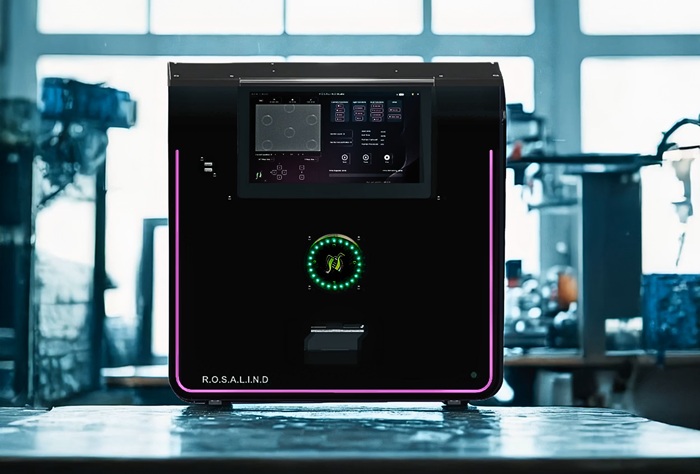Blood Test Can Accurately Detect Alzheimer's Disease
|
By LabMedica International staff writers Posted on 01 Nov 2015 |

Image: Schematic diagram of how microtubules disintegrate with Alzheimer\'s disease (Photo courtesy of US National Institute on Aging).
A blood test that can accurately detect the presence of Alzheimer's disease is being developed which would give physicians an opportunity to intervene at the earliest, most treatable stage.
As blood vessels in the brain weaken or become brittle with age, they begin to leak, which allows plasma components including brain-reactive autoantibodies into the brain. There, the autoantibodies can bind to neurons and accelerate the accumulation of β-amyloid deposits, a hallmark of Alzheimer's pathology.
Scientists at the Rowan University School of Osteopathic Medicine (Stratford, NJ, USA) have focused focuses on utilizing autoantibodies as blood-based biomarkers to accurately detect the presence of myriad diseases and pinpoint the stage to which a disease has progressed. By detecting Alzheimer's disease long before symptoms emerge, they hope those with disease-related autoantibody biomarkers will be encouraged to make beneficial lifestyle changes that may help to slow development of the disease.
All humans possess thousands of autoantibodies in their blood and these autoantibodies specifically bind to blood-borne cellular debris generated by organs and tissues all over the body. An individual's autoantibody profile is strongly influenced by age, gender and the presence of specific diseases or injuries, and diseases cause characteristic changes in autoantibody profiles that, when detected, can serve as biomarkers that reveal the presence of the disease. The blood test developed by the team has also shown promise in detecting other diseases, including Parkinson's disease, multiple sclerosis, and breast cancer.
The team developed a microarray, a slide dotted with tiny proteins that light up in reaction to certain autoantibodies, to test for very early stages of Alzheimer’s disease. To test the blood for specific autoantibodies, the investigators took a drop of blood and smeared it on a microarray, a 2.54-cm by 7.62-cm slide dotted with 23,500 tiny proteins, about a third of all proteins made in the human body. When scanned with a laser, the proteins light up in reaction to certain autoantibodies. The brighter the color, the more of that autoantibody is present.
Robert Nagele, PhD, the senior author of the study said, “There are significant benefits to early disease detection because we now know that many of the same conditions that lead to vascular disease are also significant risk factors for Alzheimer's. People found to have preclinical disease can take steps to improve their vascular health, including watching their diet, exercising and managing any weight and blood pressure issues to help stave off or slow disease progression.” The study was presented at the Osteopathic Medical Conference & Exposition, held October 17–21, 2015, in Orlando (FL, USA).
Related Links:
Rowan University School of Osteopathic Medicine
As blood vessels in the brain weaken or become brittle with age, they begin to leak, which allows plasma components including brain-reactive autoantibodies into the brain. There, the autoantibodies can bind to neurons and accelerate the accumulation of β-amyloid deposits, a hallmark of Alzheimer's pathology.
Scientists at the Rowan University School of Osteopathic Medicine (Stratford, NJ, USA) have focused focuses on utilizing autoantibodies as blood-based biomarkers to accurately detect the presence of myriad diseases and pinpoint the stage to which a disease has progressed. By detecting Alzheimer's disease long before symptoms emerge, they hope those with disease-related autoantibody biomarkers will be encouraged to make beneficial lifestyle changes that may help to slow development of the disease.
All humans possess thousands of autoantibodies in their blood and these autoantibodies specifically bind to blood-borne cellular debris generated by organs and tissues all over the body. An individual's autoantibody profile is strongly influenced by age, gender and the presence of specific diseases or injuries, and diseases cause characteristic changes in autoantibody profiles that, when detected, can serve as biomarkers that reveal the presence of the disease. The blood test developed by the team has also shown promise in detecting other diseases, including Parkinson's disease, multiple sclerosis, and breast cancer.
The team developed a microarray, a slide dotted with tiny proteins that light up in reaction to certain autoantibodies, to test for very early stages of Alzheimer’s disease. To test the blood for specific autoantibodies, the investigators took a drop of blood and smeared it on a microarray, a 2.54-cm by 7.62-cm slide dotted with 23,500 tiny proteins, about a third of all proteins made in the human body. When scanned with a laser, the proteins light up in reaction to certain autoantibodies. The brighter the color, the more of that autoantibody is present.
Robert Nagele, PhD, the senior author of the study said, “There are significant benefits to early disease detection because we now know that many of the same conditions that lead to vascular disease are also significant risk factors for Alzheimer's. People found to have preclinical disease can take steps to improve their vascular health, including watching their diet, exercising and managing any weight and blood pressure issues to help stave off or slow disease progression.” The study was presented at the Osteopathic Medical Conference & Exposition, held October 17–21, 2015, in Orlando (FL, USA).
Related Links:
Rowan University School of Osteopathic Medicine
Latest Immunology News
- Blood Test Could Identify Colon Cancer Patients to Benefit from NSAIDs
- Blood Test Could Detect Adverse Immunotherapy Effects
- Routine Blood Test Can Predict Who Benefits Most from CAR T-Cell Therapy
- New Test Distinguishes Vaccine-Induced False Positives from Active HIV Infection
- Gene Signature Test Predicts Response to Key Breast Cancer Treatment
- Chip Captures Cancer Cells from Blood to Help Select Right Breast Cancer Treatment
- Blood-Based Liquid Biopsy Model Analyzes Immunotherapy Effectiveness
- Signature Genes Predict T-Cell Expansion in Cancer Immunotherapy
- Molecular Microscope Diagnostic System Assesses Lung Transplant Rejection
- Blood Test Tracks Treatment Resistance in High-Grade Serous Ovarian Cancer
- Luminescent Probe Measures Immune Cell Activity in Real Time
- Blood-Based Immune Cell Signatures Could Guide Treatment Decisions for Critically Ill Patients
- Novel Tool Predicts Most Effective Multiple Sclerosis Medication for Patients
- Companion Diagnostic Test for CRC Patients Identifies Eligible Treatment Population
- Novel Tool Uses Deep Learning for Precision Cancer Therapy
- Companion Diagnostic Test Identifies HER2-Ultralow Breast Cancer and Biliary Tract Cancer Patients
Channels
Clinical Chemistry
view channel
POC Breath Diagnostic System to Detect Pneumonia-Causing Pathogens
Pseudomonas aeruginosa is a major cause of hospital-acquired and ventilator-associated pneumonia, particularly in lung transplant recipients and patients with structural lung disease. Its ability to form... Read more
Online Tool Detects Drug Exposure Directly from Patient Samples
Doctors often rely on patient interviews and medical records to determine what medications a person has taken, but this information is frequently incomplete. People may forget drugs they used, take over-the-counter... Read moreMolecular Diagnostics
view channel
DNA Detection Platform Enables Real-Time Molecular Detection
A next-gen DNA detection platform enables real-time molecular detection by detecting nucleic acids directly without enzymes or thermocyclers, thereby slashing costs, reducing complexity, and boosting reliability... Read more
STI Molecular Test Delivers Rapid POC Results for Treatment Guidance
An affordable, rapid molecular diagnostic for sexually transmitted infections (STIs) has the potential to be globally relevant, particularly in resource-limited settings where rapid, point-of-care results... Read moreHematology
view channel
MRD Tests Could Predict Survival in Leukemia Patients
Acute myeloid leukemia is an aggressive blood cancer that disrupts normal blood cell production and often relapses even after intensive treatment. Clinicians currently lack early, reliable markers to predict... Read more
Platelet Activity Blood Test in Middle Age Could Identify Early Alzheimer’s Risk
Early detection of Alzheimer’s disease remains one of the biggest unmet needs in neurology, particularly because the biological changes underlying the disorder begin decades before memory symptoms appear.... Read more
Microvesicles Measurement Could Detect Vascular Injury in Sickle Cell Disease Patients
Assessing disease severity in sickle cell disease (SCD) remains challenging, especially when trying to predict hemolysis, vascular injury, and risk of complications such as vaso-occlusive crises.... Read more
ADLM’s New Coagulation Testing Guidance to Improve Care for Patients on Blood Thinners
Direct oral anticoagulants (DOACs) are one of the most common types of blood thinners. Patients take them to prevent a host of complications that could arise from blood clotting, including stroke, deep... Read moreMicrobiology
view channel
Breakthroughs in Microbial Analysis to Enhance Disease Prediction
Microorganisms shape human health, ecosystems, and the planet’s climate, yet identifying them and understanding how they are related remains a major scientific challenge. Even with modern DNA sequencing,... Read more
Blood-Based Diagnostic Method Could Identify Pediatric LRTIs
Lower-respiratory tract infections (LRTIs) are a leading cause of illness and death worldwide, and pneumonia is the leading infectious cause of death in children under five, claiming the lives of over... Read morePathology
view channel
Rapid Low-Cost Tests Can Prevent Child Deaths from Contaminated Medicinal Syrups
Medicinal syrups contaminated with toxic chemicals have caused the deaths of hundreds of children worldwide, exposing a critical gap in how these products are tested before reaching patients.... Read more
Tumor Signals in Saliva and Blood Enable Non-Invasive Monitoring of Head and Neck Cancer
Head and neck cancers are among the most aggressive malignancies worldwide, with nearly 900,000 new cases diagnosed each year. Monitoring these cancers for recurrence or relapse typically relies on tissue... Read more
Common Health Issues Can Influence New Blood Tests for Alzheimer’s Disease
Blood-based tests for Alzheimer’s disease are transforming diagnosis by offering a simpler alternative to spinal taps and brain imaging. However, many people evaluated at memory clinics also live with... Read more
Blood Test Formula Identifies Chronic Liver Disease Patients with Higher Cancer Risk
Chronic liver disease affects millions worldwide and can progress silently to hepatocellular carcinoma (HCC), one of the deadliest cancers globally. While surveillance guidelines exist for patients with... Read moreTechnology
view channel
Machine Learning Models Diagnose ALS Earlier Through Blood Biomarkers
Amyotrophic lateral sclerosis (ALS) is a rapidly progressive neurodegenerative disease that is notoriously difficult to diagnose in its early stages. Early symptoms often overlap with other neurological... Read more
Artificial Intelligence Model Could Accelerate Rare Disease Diagnosis
Identifying which genetic variants actually cause disease remains one of the biggest challenges in genomic medicine. Each person carries tens of thousands of DNA changes, yet only a few meaningfully alter... Read moreIndustry
view channel
BD and Penn Institute Collaborate to Advance Immunotherapy through Flow Cytometry
BD (Becton, Dickinson and Company, Franklin Lakes, NJ, USA) has entered into a strategic collaboration with the Institute for Immunology and Immune Health (I3H, Philadelphia, PA, USA) at the University... Read more




















